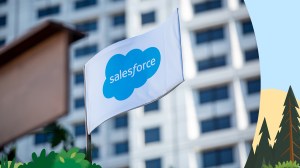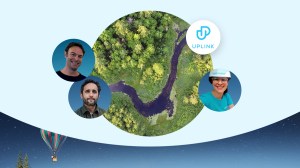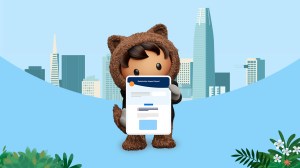We’ve all had a great customer experience. Maybe it was a barista who knew your order when you walked in, or the grocery store employee who put aside a favorite item before it was sold out. Whatever it was, the experience left you feeling happier, more energized, and in this case — more caffeinated.
For Josh Gray, Salesforce’s Senior Director of Employee Experience, it was talking to his parental leave vendor’s support agents. We sat down with Josh who leads the newly minted Employee Experience team at Salesforce to hear the story, how it inspired the work he does at Salesforce, and more.
Q. An employee experience that stands out in your mind came from a surprising source — a call center. What made it great?
Three years ago, I was applying for parental leave, and any time I reached out to the vendor that provided this benefit, the agent would hyper-personalize the conversation.
Before our daughter was born, for example, the agents would always ask, “How’s your wife feeling?” After our daughter was born, they always opened the call with, “Congratulations, how are things going?” and made friendly chit chat. It really felt like they were relating to who I was and the experience I was in.
The reason I loved it so much was because it felt like they cared. They catered to my needs, most of the time even before I verbalized them. I think that’s important in the moments that matter, as they can be high in emotion.
Q. You run a new team at Salesforce around employee experience. Why is employee experience so important?
When you’re on a plane, they say, “In the event of an emergency, put your own oxygen mask on first, before helping others.”
If employees’ needs aren’t met, there’s no way that they can show up for customers in the way that we expect them to.
Q. That sounds nice, but can focusing on employee experience really make a difference?
Salesforce’s Experience Advantage research showed that focusing on employee experience in the right way — the right team, the right resources, the right capabilities, the right funding and investments — can help organizations see increased revenue growth up to 50%.
Typically, HR is not seen as a revenue-producing function. But if you can make the employee experience more simple, easy and efficient, that leads to higher engagement and higher productivity, which directly impacts a company’s bottom line. That’s where businesses can begin recognizing employee experience as a business imperative, versus simply an HR imperative.
Q. “Quiet quitting” has been in the news lately. What’s your opinion of this phenomenon?
“Quiet quitting” is a rebrand of employee withdrawal and disengagement. We’ve seen employee disengagement for as long as work has been around.
The “quiet” part comes from it being less visible than it was historically. More people are working either fully remotely or in a hybrid environment, so we’re not necessarily seeing the disengagement in the same physical spaces.
The solution has always been to understand who people are, what they need, and how we can meet those needs. How do we understand and provide that delightful employee experience as they’re moving along each stage of their career journey?
Disengagement is something that will continue to be prevalent in the workplace until more organizations truly approach employee experience in a needs-first, human-centric way.
Q. How is Salesforce approaching employee experience differently than we have in the past?
What has gotten organizations here today is not going to be what gets them where they want to go in the future. And so, employee experience requires an entirely new mindset — a new, innovative way of thinking.
Salesforce realized the need to evolve, and created the Employee Experience (EX) team to address this need. The team is made up of folks who specialize in a discipline called Service Design, which draws on human-centered design to better orchestrate experiences for customers and employees, and uses empathy as a starting point.
Service Design can be thought of as a mindset, methodology, and a set of tools to craft services that not only consider the user – a.k.a. employee – but all of the people, systems, and interactions involved in that particular ecosystem.
Q. How does the Salesforce Employee Experience team use data to inform its work?
The foundation of all our work is research. We start with quantitative data, such as retention and attrition trends and employee survey results, to understand what’s going on within the organization or segments of the organization. Then we drill down to the core issues through qualitative data like interviews, ethnographies, diary studies and more to understand the “why.”
When we have those insights, it helps us get really clear on what we need to address that will significantly move the needle and improve the experience for our employees.
Q: What do you think makes Salesforce’s employee experience unique?
What makes the company special — to me — is how it recognizes that people are our number one asset – and invests accordingly. As a result, the company has embraced a human-centric mindset, which is critical to this work.
A human-centric mindset means that the employee is at the center of everything we do. We’re bringing employees along on the journey; and they are helping us to co-create the solutions they want that will make their jobs easier. And then of course, helping us to test and iterate to improve along the way.
By the time we actually get to implementing something, we have a high degree of confidence that it’s going to work, because the employee has been at the heart of the process the whole time.
We’re starting to see early indications that this work is paying off. Today, Salesforce was named one of the two Best Workplaces in Technology by Great Places to Work for 2022.
By shifting to a human-centered approach, companies can ensure they are designing experiences that are efficient, effective, and usable by the humans engaging with the solution.
Josh Gray
Q. What actions can organizations take now to improve employee experience?
First and foremost, create a team and dedicate resources to it. For this work to be successful, it has to be a core responsibility as opposed to a side job.
Next, you have to drive adoption of the human-centric mindset. Most companies follow a more traditional, solution-driven approach, which does not always consider the solution holistically from a user’s perspective. But that method can often miss the core issue. By shifting to a human-centered approach, companies can ensure they are designing experiences that are efficient, effective, and usable by the humans engaging with the solution. It’s going to feel different, especially in the way that work typically gets done in an HR function, but the successes will have tremendous impact that will be felt across the organization.
And finally, you have to ensure that the right listening mechanisms are in place. At Salesforce, we take several methods to listen: surveys, interviews, focus groups, and Slack channels to name a few. If we don’t know who our people are or what they need,we can’t deliver experiences that move the needle in a meaningful way. Practicing deep listening and having empathy for our users brings us into the mindset of the people we are solving problems for, and lets us be more effective.
More information
- Read about Trailblazer Ranch, which is helping to ignite the next chapter of Salesforce’s culture.
- Check out this collection of Success From Anywhere news and stories.
- Follow Josh on LinkedIn to stay updated on the Employee Experience team.















